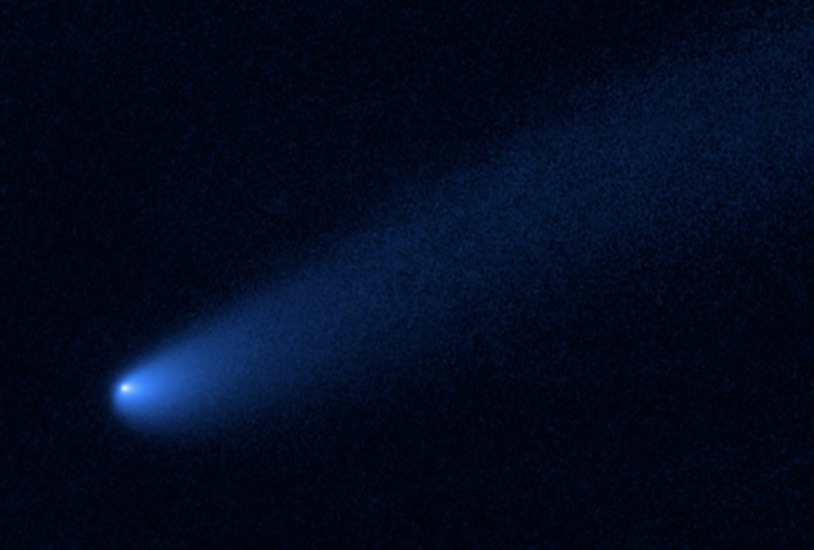From our recent article on the most interesting asteroids and comets, many of the asteroids there are active. They showcase cometary activity even though they may not contain lots of volatiles. Today, let’s explore active asteroids and why they look like comets in this article.
Rotational Spinups
Sometimes, an asteroid becomes active because of increased rotational speed. This is induced by the YORP effect, where the asymmetric reception of sunlight influences the rotation of a small object. While it could change the asteroid’s rotation in every way around depending on different parameters, the pressure may go along the object’s rotation. This causes the asteroid to spin faster and causes its rotational period to decrease.
This change in rotation causes centrifugal forces to increase around the asteroid, pulling its equatorial regions apart. And as the rotation speeds up, the forces exceed the gravitational forces pulling the asteroid together, causing it to break apart. This creates large amounts of dust apart from ejecting significant fragments, causing a comet-like dust cloud and tail to be seen around the asteroid. This is why the asteroid 6478 Gault appears more like a comet in some images, and the asteroid P/2013 R3 magnificently broke apart and disappeared from view.
Impacts
Sometimes, asteroids also become momentarily active due to impacts with other asteroids. Asteroids tend to have a weak gravity or could even be loosely bound, so any impact, even with a small impactor, could send large amounts of material flying off into space. This event forms a tail trailing the asteroid, and in some cases, it could even form moons around asteroids.
A prominent example is the impact of the DART spacecraft with the asteroid Dimorphos, a satellite of 65803 Didymos. Remember that the spacecraft’s mass is only about half a ton, and the impact speed is only about 6.4 km/s. While this may seem fast from your perspective, it’s a very slow impact, even in the scales of the Solar System. Still, it created a magnificent tail around the asteroid, which the Hubble Space Telescope promptly captured.

Image credit: NASA, ESA, STScl
Release of Volatiles
Sometimes, active asteroids are just more like comets than asteroids. They may still have volatiles under their surface and released through an active surface layer. In fact, this has happened on a few asteroids, including 288P/2006 VW139 and 313P/Gibbs (Jewitt et al., 2015). Another interesting example is 3200 Phaethon, whose activity may be caused by fizzing sodium inside the asteroid when it gets very close to the Sun. The force of the gas then ejects particles out from the surface of the asteroid, creating the Geminids meteor shower.
In some cases, the release of volatile materials may be explosive, causing large outbursts that brighten the asteroid significantly and give it a comet-like appearance. As the asteroid goes around the Sun and gets near it at times, gaseous volatiles could build up inside the asteroid, creating pressure trying to pull the asteroid apart. Eventually, as the pressure goes past the breaking point, a part of the inactive crust falls off from the object, and large amounts of volatiles get released. In fact, this has happened to the comet 17P/Holmes. Although it was a comet in the first place, a sudden outburst caused by an explosive release of volatiles (Altenhoff et al., 2009), substantially increased the object’s brightness, turning it from a very faint comet to a bright, naked-eye object.
Why Are Active Asteroids Interesting?
Now that we’ve discussed the three reasons why asteroids become active, a question remains. Why are they fascinating targets for exploration? Well, that’s because their activity freshly exposes the subsurface layers of the object. For example, the Deep Impact mission, which struck comet Tempel 1 in 2005, worked by sending an impactor to its surface, exposing the material of the comet just beneath its surface. The aftermath of the impact contributed to many pieces of research in the years following the event, helping us learn more about the origin and evolution of comets. By observing these natural events in asteroids, one can achieve a similar effect as well.
Conclusion
To conclude, we have introduced active asteroids in this article. We have discussed why asteroids could become active, including rotational spinup, impact, or sublimation, and how these asteroids could be valuable scientific targets as they expose information about the layers beneath their surfaces. If you want to learn more about these objects, please visit the webpages in the references below.
References
- (2021, August 16). “Fizzing Sodium Could Explain Asteroid Phaethon’s Cometlike Activity”. Retrieved December 23, 2022, from https://www.jpl.nasa.gov/news/fizzing-sodium-could-explain-asteroid-phaethons-cometlike-activity
- Attenhoff, W. J., et al. (2008, June 25). “Why did Comet 17P/Holmes burst out? Why did Comet 17P/Holmes burst out? Nucleus splitting or delayed sublimation?” Retrieved December 23, 2022, from https://www.aanda.org/articles/aa/full_html/2009/09/aa10458-08/aa10458-08.html
- Garner, R. (2019, March 28). “Hubble Watches Spun-Up Asteroid Coming Apart”. Retrieved December 23, 2022, from https://www.nasa.gov/feature/goddard/2019/hubble-watches-spun-up-asteroid-coming-apart
- Jewitt, D., et al. (2015, February 9). “The Active Asteroids”. Retrieved December 23, 2022, from https://arxiv.org/abs/1502.02361

